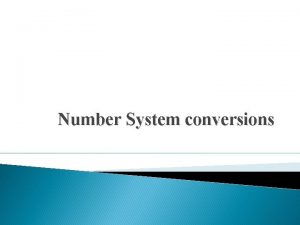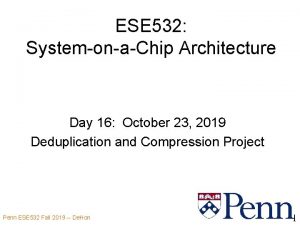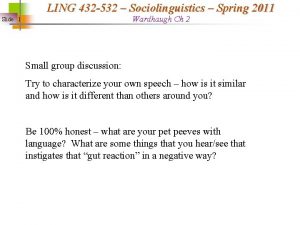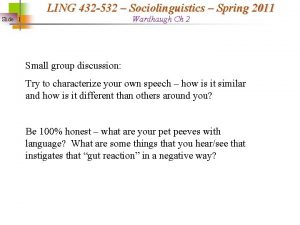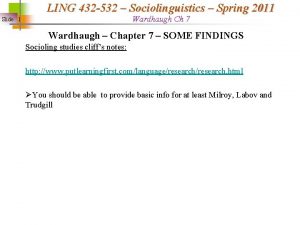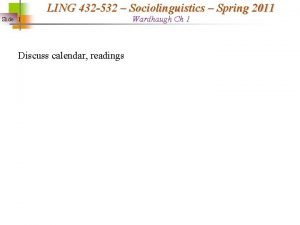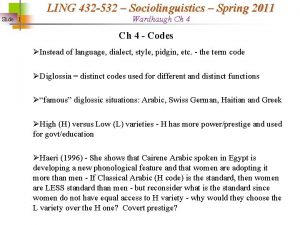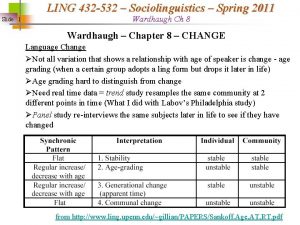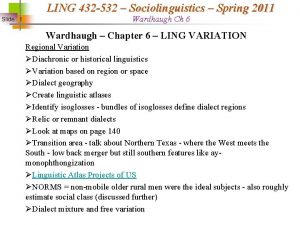LING 432 532 Sociolinguistics Spring 2011 Wardhaugh Ch








- Slides: 8

LING 432 -532 – Sociolinguistics – Spring 2011 Wardhaugh Ch 5 Slide 1 Calendar Wardhaugh Ch 5 Also will discuss Milroy & Milroy article on Tuesday (notes from me up by Saturday) Quiz 1 on Thursday Particularly “the observer’s paradox” - how does Labov resolve this? Listen to NPR clip William Labov - NYC

LING 432 -532 – Sociolinguistics – Spring 2011 Slide 2 Wardhaugh Ch 5 Wardhaugh – Chapter 5 SPEECH COMMUNITY ØTheoretical dilemma defining “speech community” as a social construct ØA group composed of members that share something socially in common (region, politics, etc. ) ØGroup may be temporary, and is also more than its members (they come and go but group still exists) ØHave preconceived expectations of behavior (including linguistics) about members of a group = stereotypes (The blender is broke) ØLabov defines it as not by linguistics elements but by “participation in a set of shared norms” (see page 120) – top-down approach (community defined by investigator) ØDiscuss Conn 2005 New Ways in Analyzing Variation (NWAV) presentation about Philadelphia

LING 432 -532 – Sociolinguistics – Spring 2011 Wardhaugh Ch 5 Slide 3 Wardhaugh – Chapter 5 SPEECH COMMUNITY Discuss Conn 2005 New Ways in Analyzing Variation (NWAV) presentation about Philadelphia

LING 432 -532 – Sociolinguistics – Spring 2011 Slide 4 Wardhaugh Ch 5 Wardhaugh – Chapter 5 SPEECH COMMUNITY ØTheoretical dilemma defining “speech community” as a social construct ØMilroy discusses that not all sociolinguistic variables have the same evaluation in different speech communities – (r) in NYC vs. England ØGumprez uses linguistic community instead (see definition on p. 122) ØSomehow connect the social with the linguistic and capture the concept/belief that we as native speakers have when we speak a variety of a language ØHymes discusses difference between participating in and being a member of speech community (see page 123 -24) ØQuestion regarding nativity – does a community member have to be native to that community to participate in the speech community? (Horvath study)

LING 432 -532 – Sociolinguistics – Spring 2011 Slide 5 Wardhaugh Ch 5 Wardhaugh – Chapter 5 SPEECH COMMUNITY ØWhat do we do about heterogeneous speech communities like London example? Or even Portland? ØThe concept of belonging to a group is relative - Do you speak English, Western US English, or North Portland English? ØCommunity of Practice - (Eckert and Mc. Connell-Ginet) - see definition p. 122 - group of people coming together to do something – more of a bottom-up approach (community defined by group members)

LING 432 -532 – Sociolinguistics – Spring 2011 Slide 6 Wardhaugh Ch 5 Wardhaugh – Chapter 5 SPEECH COMMUNITY - NETWORKS ØDense = if you know and interact with people who also know and interact with the same people (all people in your network are connected) ØIf not, then Loose ØMultiplex = if people in the network are tied to each other in multiple ways (you work, live with, hang out with your brother/sister) ØSocial networks connected to social class (James and Leslie Milroy) ØDiscuss Milroy & Milroy, 1992

LING 432 -532 – Sociolinguistics – Spring 2011 Wardhaugh Ch 5 Slide 7 Milroy & Milroy SPEECH COMMUNITY – NETWORKS vs. Socioeconomic Class (SEC) ØTheir Belfast study ØVariables? ØFindings? P. 12 ØWeak ties vs. strong ties (Labov Martha’s vineyard study) ØWhat’s the difference between social network analysis and SEC analysis? Guy (1988) discusses micro- vs. macrosociological levels (p. 17). ØAlso, Labov seems to use network as methodological tool rather than anlaysis tool – EXPLAIN

LING 432 -532 – Sociolinguistics – Spring 2011 Slide 8 Wardhaugh Ch 5 Milroy & Milroy SPEECH COMMUNITY – NETWORKS vs. Socioeconomic Class (SEC)




